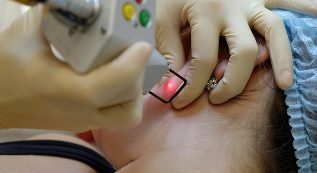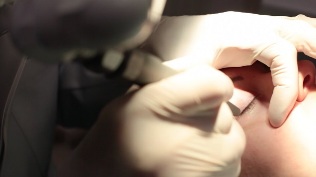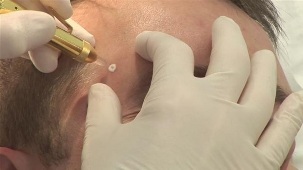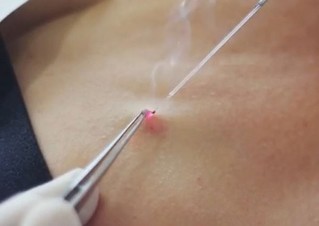
The removal of neoplasms with a laser is a very common and effective method with which unwanted growths can be eliminated. This is a relatively new method that appeared in the medical arsenal not so long ago but has already proven its advantage over other removal methods. The precursors to laser destruction were removal with liquid nitrogen, electricity, or a scalpel. All of this can cause significant discomfort to the patient, while laser removal shows high results in painless procedures.
Why
remove?Papillomas, which are growths of various shapes and sizes, are usually benign neoplasms. They are located on the mucous membranes of the wearer or his skin. The main reason for their occurrence is the action of the human papillomavirus, which in most cases is sexually transmitted.
Removing these superstructures performs several tasks at the same time:
- Aesthetic correction.A growing patient may feel uncomfortable if others pay too much attention to him. Because of this, a person can feel insecure and uncomfortable even if the growth does not pose a threat to them.
- Prevention of injuries.If the growth is in a traumatic place where the patient is constantly touching it, it can lead to the separation of the protruding part. Additionally, trying to cover the papilloma with clothes can cause problems such as rubbing the affected area. This is fraught with injury to the papilloma and possible subsequent infection. The damage can cause microbes to invade, which can lead to inflammation in the wound. In this case, it is necessary to treat the damaged area with peroxide and immediately go to the clinic to remove the remaining part of the papilloma.
- Reduce the risk of cancer.Despite the fact that growths are naturally benign, there is such a variety of their manifestation as warts. They are usually in intimate places and are very dangerous for the development of cancer. To prevent the disease, all warts must be removed.
Do not remove growths yourself. Any attempt to tie a papilloma with a thread, comb it, or apply a chemical agent to it can worsen its condition.
Advantages of the process
Laser destruction has several advantages over other removal methods.These include:
- Guaranteed result.Thanks to the action of the laser, the outgrowth is completely removed and nothing remains in the deep subcutaneous layers. The device can penetrate deep enough to remove all traces of neoplasm.
- Painlessness.Exposure to the laser causes minimal pain for the patient. If you add pre-anesthesia with local anesthetic to the procedure, there will be no pain at all.
- procedure speed. Removal of papillomas with a laser takes 2 to 5 minutes per element.
- Non-invasiveness.The laser beam is in a strictly limited area and does not go beyond it. In this case, more than one part of the laser does not touch the surgical site. This is very important as this method minimizes the risk of infection and offers a high guarantee of sterility.
- No post-operative scars.If the work is done correctly, there should be no traces of the laser action at the point of exposure. This is because the affected tissue has completely evaporated, and then new, intact skin takes its place.
- Bloodless method of erasure.The laser beam heats the blood supplying capillaries and quickly seals their walls. As a result, the bleeding stops and does not continue after surgery.
- Suitable for different parts of the body.Not all removal methods can be used on every part of the body. Intimate places, eyelids, etc. are considered to be particularly sensitive. Laser destruction can cope well with growth in such areas due to the precision of the laser beam.
All of these factors make laser removal one of the most sought-after procedures for getting rid of growths.
Contraindications
The list of contraindications for this procedure is not as long as for other methods of destruction.Among the prohibitions on laser removal:
- Diabetes mellitus;
- oncology;
- aggravation of chronic diseases;
- epilepsy;
- diseases associated with problems of the endocrine system;
- poor blood clotting;
- HIV or AIDS;
- acute inflammatory diseases.
In addition, patients who have recently had influenza or acute respiratory infections should postpone the procedure for some time.
Procedure description
Before beginning a procedure to remove growths, the doctor disinfects the area to be operated on. In some cases, local anesthetic pain relief is used. Typically an ointment or spray is used for this. After the anesthetic is applied, 2-3 minutes will pass and the removal process will begin.

The laser beam is directed onto the affected area and, so to speak, cauterizes the unwanted growth. At this moment, under the influence of the laser, the contents of the cells are vaporized, removing every layer of the affected tissue. This does not only happen in easily accessible places outdoors. The procedure for removing papillomas, for example on the eyelid, is the same. The only nuance of this area is that a special method of cooling is used for the patient to prevent pain and burns at this sensitive point.
Neoplasms in intimate places are removed using the same principle. But here the doctor usually uses anesthetic injection as an anesthetic, with the growth being injected from different sides.
The moment of inserting the needle can be a little painful, but after a few minutes the sensitivity in the area of influence disappears completely and further manipulations are completely painless.
The affected area turns into a small wound with no blood. At the time of destruction, it is disinfected due to the work of the laser. After removing the debris, the doctor will treat the affected area with potassium permanganate.
After the procedure, the patient may experience slight redness, itching, or pain at the site of the papilloma removal.
This reaction is considered normal because, despite the non-invasive nature of the procedure, there was an interference with the integrity of the skin during the operation.All symptoms should go away completely 2-4 days after the procedure.
A dry crust later appears over the wound. Underneath there is a layer of already healthy skin so that the protective cover can only be torn off when it falls off by itself. Otherwise, a scar may be left on the skin and the recovery process itself may take longer.
Follow
Complications after laser destruction are rare. Their presence is usually associated with diseases that the patient already has and that he did not cure before the procedure. For example, if the patient has had an inflammation of the skin, this may contribute to the appearance of pigmentation. If the skin itself is very sensitive, there may be a slight reddening associated with a burn. With a high allergic reaction, edema may occur at the exposure site.
In order to rule out all undesirable consequences, a doctor must be consulted before the laser is destroyed.
Care after the procedure
After removing the abutment, the patient must adhere to the following rules:
- Do not let water get into the wound for 2-3 days.
- do not visit saunas, baths and swimming pools;
- Do not rub the damaged area with a towel.
- do not put an adhesive plaster on the wound;
- Do not treat the papilloma removal site with scrubs or lotions containing alcohol.
- Avoid exposure to ultraviolet rays.
Antiseptic treatment of the wound must be carried out several times a day. This must be done by the moment the scab is separated. This treatment should prevent infection and speed up the time for full healing.To treat the damaged area, you can take iodine or a solution of potassium permanganate.
After removal, the area can be treated with anti-inflammatory ointments.
Its effect is aimed at accelerating tissue regeneration and reducing inflammation and edema. Before choosing a particular remedy, it is best to consult a doctor.
Which method is better
Laser removal isn't the only way to deal with unwanted growth. There are also other possibilities that stand out:

Cryodestruction.
Based on the removal of papillomas with liquid nitrogen. Due to low temperatures, the structure begins to collapse and eventually disappears completely. The method is effective but has several disadvantages. Among them is the impossibility of having complete control over the depth of exposure to nitrogen. The substance can penetrate very deeply, touch a healthy area or, on the contrary, only have a superficial effect without affecting all localization layers of the structure.
This method is also identified by:
- the possibility of post-operative scars;
- painful sensations;
- Inability to guarantee the result after the first operation.
Thus, laser destruction shows a greater efficiency compared to cryodestruction. Removal with a laser is less painful and more likely to guarantee the desired result.
Removing radio waves.
This method of destruction is carried out with a special device that acts on the papilloma via radio waves. This promotes the removal of the superstructure due to the tip effect of the radio knife. The precision of the procedure is very high, so that the adjacent tissues are not affected. However, the risk of burns or infections is extremely small.
This method is suitable for removing small benign lesions. It is highly efficient which makes it as popular as laser destruction. Both methods are considered modern approaches to papilloma removal and are used equally well in medicine.

Electrocoagulation.
This method is based on the action of a high-frequency electric current that acts on the papilloma directly at the site of the lesion. Electrocoagulation is now considered a common but outdated method. This method allows you to prevent bleeding after removing the papilloma by burning the vessels.
However, when using high-frequency electricity, patients experience pain that occurs even after anesthesia. This leads some patients to give up electrocautery and opt for laser removal as a more advanced and painless method.
Estimated costs
The price range depends not only on the region and clinic where the removal is performed, but also on the number, size and location of the removed growths.
In many clinics there is a discount for the removal of neoplasms in large quantities: the more a patient has, the cheaper it is to remove a growth.
Removing a growth in the genital area can be significantly more expensive than on other parts of the body. In addition, due to the complexity of such manipulation, not every clinic offers such a service.













































































